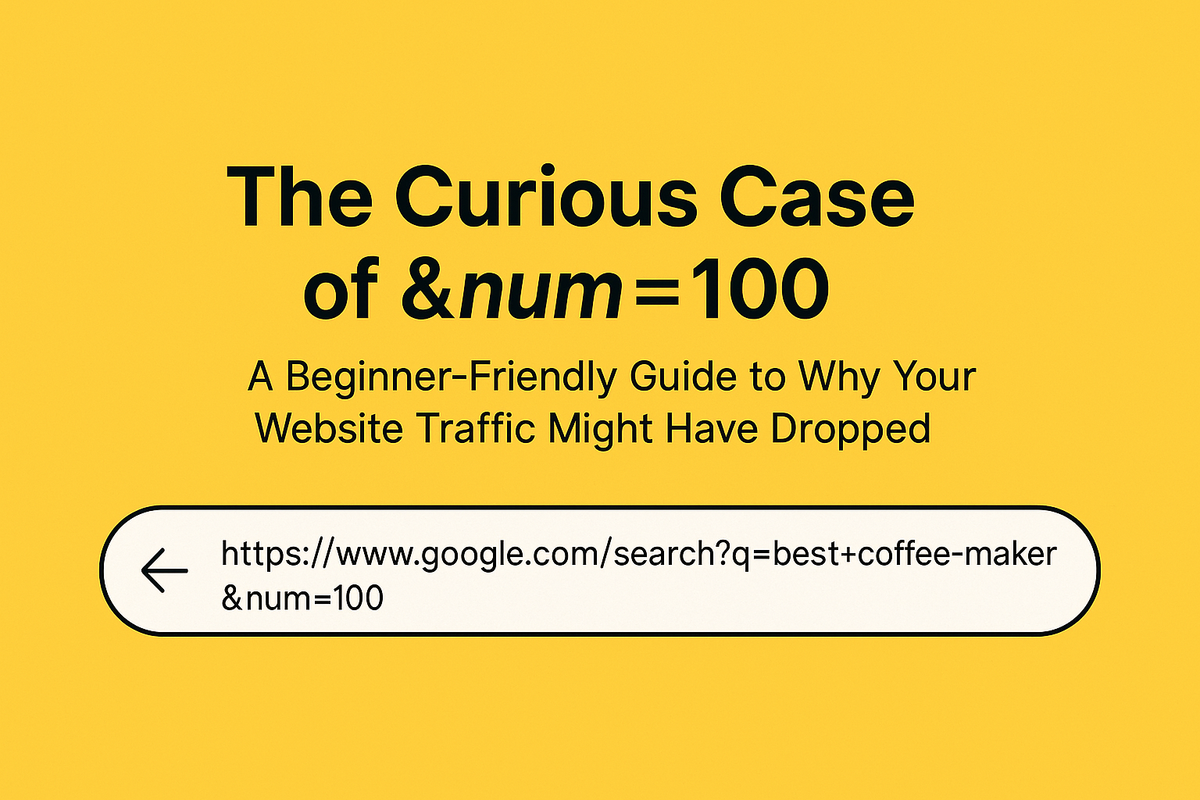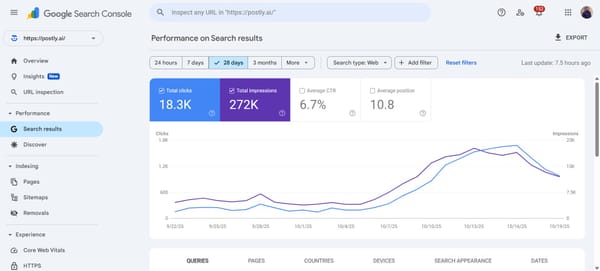The Curious Case of &num=100: A Beginner-Friendly Guide to Why Your Website Traffic Might Have Dropped

The Curious Case of &num=100 — Why Your Traffic “Dropped” Overnight
Ever checked your dashboard and watched impressions nosedive while average position got better? You’re not cursed — Google quietly retired a tiny URL parameter that powered a surprising amount of reporting.

Short story: your audience probably didn’t vanish; your metrics did a wardrobe change. Around September 2025, Google’s search results stopped honoring a parameter called &num=100, which used to force 100 results on a page. That one tweak made impressions fall, average positions look prettier, and rank-tracking tools grumpy.
Impressions ↓Avg. Position ↑Clicks ≈ A reporting change — not necessarily a ranking drop.
What on Earth Is &num=100?
When you run a Google search, the results page URL is packed with query parameters. For years, adding &num=100 looked like a harmless superpower:
https://www.google.com/search?q=best+coffee+maker&num=100Translation: “Hey Google, please show me 100 results on this page instead of the usual ~10.”
Why everyone loved it:
- SEOs: scan the top 100 at a glance, spot opportunities beyond page 1.
- Tools & scripts: grab more data with fewer requests (hello efficiency).
- Analysts: measure impressions from positions 11–100 without juggling page-by-page pagination.
And Then… It Vanished
In mid-September 2025, the SEO corners of the internet noticed a strange glitch: &num=100 stopped behaving. Asking for 100 results no longer consistently returned 100 results. Suddenly, many tools were back to the default ~10 per page.
Within days, dashboards everywhere reacted:
- Impressions fell — sometimes 30–60%.
- Average position improved (math gets nicer when you remove deep rankings).
- Clicks often stayed about the same.
It wasn’t a penalty or secret “doom update” — it was a measurement shift.
- Reduce scraping: one query returning 100 results = bot paradise.
- Reflect real behavior: most humans don’t go past page 1.
- Infra sanity: smaller, consistent batches are easier to serve reliably.
- Fewer “ghost impressions” from pages no one visits.
- Nicer averages (less drag from page-7 rankings).
- Rank trackers need 10× more requests to see position 100.
Real-World Stories
🧼 Jane’s Handmade Soaps
Jane opens Search Console. Impressions fell from 140k → 90k overnight. Panic! But clicks are flat. The missing impressions? Mostly terms where she ranked around #70 — pages no one visited anyway.
🏢 Alex’s SEO Agency
Alex’s rank-tracker used &num=100 to fetch the whole top-100 in one go. Now it needs to paginate pages 1→10. Costs rise, depth shrinks if they throttle, and the week is spent explaining “no, your rankings didn’t nosedive, the data pipe got thinner.”
📈 Morgan the Marketing Manager
The CMO asks, “Why down 40%?” Morgan: “Because we stopped counting results nobody saw.” Lunch is saved.
So… Did My Traffic Really Drop?
Maybe — but probably not because of this. The common pattern is:
- Impressions: drop (fewer deep results counted)
- Average Position: improves (you removed low positions from the pool)
- Clicks: roughly steady (real humans were clicking the same top results)
Think of it like your analytics went on a diet. Less fluff, more signal.
How to Think About Metrics After &num=100
- Clicks & CTR first: these reflect human actions, not bot-friendly inventory.
- Top-10 (page-1) visibility: that’s where the traffic pie gets eaten.
- Impressions with context: useful, but more volatile now — annotate your timelines.
- Conversions: always the North Star.
| Metric | Before (num=100) | After (removed) | Meaning |
|---|---|---|---|
| Impressions | 140,000 | 90,000 | Fewer deep results counted |
| Average Position | 34 | 28 | Less drag from page-7 rankings |
| Clicks | ≈ 5,100 | ≈ 5,000 | Essentially stable |
| CTR | 3.6% | 5.5% | Less denominator noise |
Action Plan (Tech & Non-Tech Friendly)
- Annotate your dashboards: mark September 2025 as “
num=100removal.” - Re-baseline reports: avoid pre-vs-post comparisons without notes.
- Talk to your tools: ask how rank-depth is collected now (pagination, cost, reliability).
- Prioritize what moves needles: top-10 rankings, user intent, landing page quality.
- Sanity check with users: clicks, conversions, and actual feedback beat vanity graphs.
Create More. Panic Less. Let Postly Handle the Posting.
While dashboards argue about impressions, your brand still needs content out there. Postly helps you draft, schedule, and publish across Instagram, LinkedIn, Facebook, TikTok, and more—solo or with your team.
- 📅 Bulk scheduling & visual calendars
- 🤝 Team approvals & brand consistency
- 🪄 Inline AI assistance for captions
- 🚀 Cross-posting without copy-paste chaos
Postly is for social publishing & automation. Keep your SEO tracking in the tools you already use—then convert insights into content with Postly.
FAQ (You’ll Get These Questions)
Should I ignore impressions now?
No—just treat them differently. Impressions are still informative, but they’re more sensitive to how Google chooses to present results. Check clicks and CTR before sounding alarms.
Can I still see where I rank beyond page 1?
Yes, but tools may need to paginate (page 1…10) which costs more and can be throttled. Ask your provider how they’re handling depth now.
Is this related to AI or SGE?
Possibly in spirit. As search evolves, Google optimizes for speed and stability. Fewer giant pages of results means less scraping and a cleaner UX—regardless of where AI goes next.
Did my rankings actually fall?
Not necessarily. If clicks and conversions held steady, you likely experienced a measurement shift rather than a ranking shift.
Turn Insight into Output — With Postly
You’ve re-baselined your metrics. Great. Now keep your channels active with a steady drumbeat of posts.
- ✍️ Draft once, adapt to multiple platforms
- 🧩 Content libraries for evergreen ideas
- 💬 Hashtag & tone helpers in the editor
- 🌙 Schedule across time zones with ease
A Handy Mini-Checklist (Post-&num=100)
- Clicks Hold steady? You’re OK.
- CTR Up a bit? Makes sense with fewer deep impressions.
- Conversions Still healthy? Focus on content & UX.
- Top-10 Terms Track movement weekly; that’s the real traffic tier.
- Annotations Add “num=100 removed (Sep 2025)” to reports.
For the Curious: A Tiny Technical Aside
Plenty of tools assumed 100 results per query request. Remove that lever and they must either accept 10 results or paginate through 10 pages to reach parity. Pagination implies more requests, higher cost, stricter rate limits, and potentially noisier sampling if they dial it back. That’s the operational reason some reports feel “thinner” now.
Final Thought: Measure Smarter, Create Braver
Metrics should serve decisions, not derail them. The end of &num=100 quietly reminds us to prize what humans actually do (click, read, subscribe, buy) over the comfort of large numbers. Let dashboards inform, not intimidate.
Keep the main thing the main thing: ship helpful content, iterate on landing pages, and build an audience that notices when you publish. The rest is noise reduction.
Written for my personal blog. Postly shout-outs included because it’s what I use to keep the publishing rhythm sane.

